If you’re a meat lover, you may have considered buying half a cow to save money and acquire high-quality beef. But the question that may arise is, “How much does a half cow cost?” The answer to this question is not straightforward, as the price may vary depending on various factors such as the cow’s location, size, and breed.
On average, the cost of a half cow can range from $1,000 to $2,500, including processing and butchering fees. However, it is essential to research and be aware of the factors that could affect the cost before investing in half a cow. In this article, we will explore the factors that affect the price of half a cow and help you estimate how much you will need to spend to acquire your meat.
What Factors Affect The Cost Of A Half Cow?
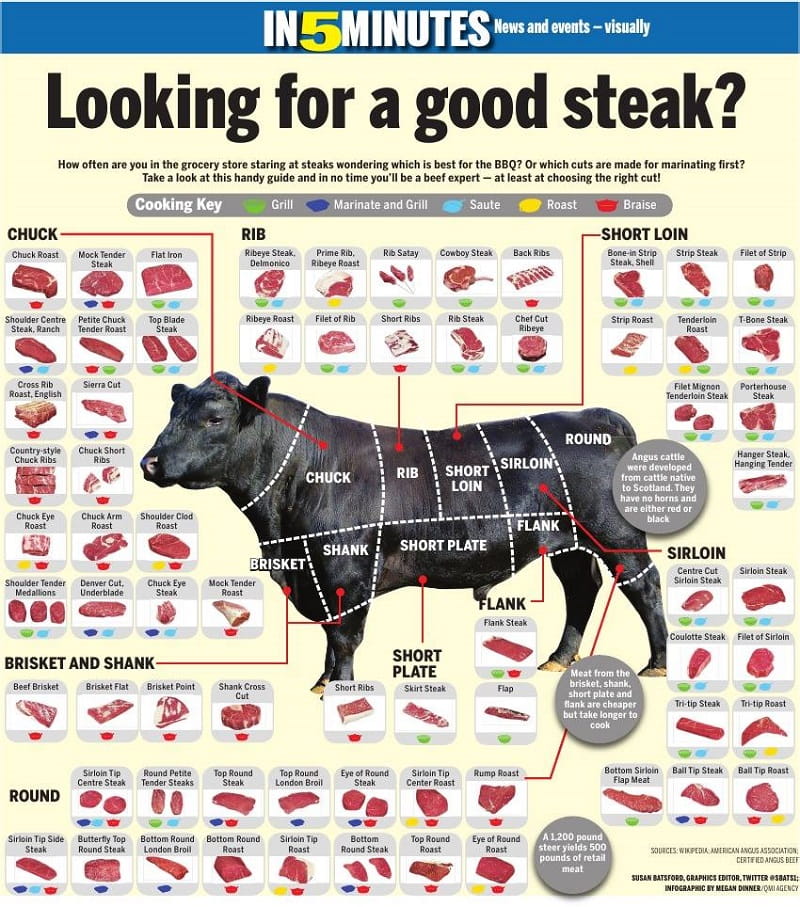
Knowing how to calculate the cost of a half cow can help you make the right decision when purchasing one. In general, the cost of a half cow depends on various factors, including the butcher’s processing fees, the cow’s weight, the quality of the meat, and the type of packaging used.
- Butcher’s Processing Fees: When you purchase a half cow, your butcher will charge you a processing fee. This fee will vary depending on the butcher’s processing type, such as grinding, cutting, or packaging the meat. The cost of the processing will also be affected by the size of the cow and the amount of time it takes to process the meat – the more complex the processing, the higher the fee.
- Weight of the Cow: The cow’s weight is also an essential factor when calculating the cost of a half cow. Generally, the heavier the cow, the more expensive it will be. The cow’s weight will also affect the amount of meat that can be processed and the size of the cuts that the butcher can produce.
- Quality of the Meat: When it comes to the quality of the meat, there are a few factors to consider. Generally, higher-quality meat will cost more than lower-quality meat. The grade of the meat can also affect the cost, with higher grades costing more than lower grades. Finally, the cow’s age can also influence the quality and cost of the meat.
- Type of Packaging: The packaging used to store and transport the meat will also affect the cost of a half cow. Vacuum-sealed bags are typically the most cost-effective option, but plastic wrap and Styrofoam containers can also be used. The type of packaging used will also affect the amount of time it takes to process the meat and the amount of meat that can be processed.
By understanding the factors that affect the cost of a half cow, you can ensure that you make the most informed decision when purchasing one.
How Much Does A Half Cow Cost?
According to facts, the price range for a half or full cow is typically between $5 and $10 per pound. To calculate the hanging weight beef price, you must factor in the processing fee of $0.50 per pound and a kill fee of $50. The hanging weight price of a half cow is around $5.50 per pound. The total cost for a half beef can range between $1,500 to $1,800, depending on the cow’s weight.
Typically, a half beef consists of approximately 185 to 225 pounds of beef. At the moment, the price for a half cow share is sold at around $6.00 per pound hanging weight. So, if you’re looking for a great deal on delicious beef, consider purchasing a half-cow today!
What Cuts Of Meat Are Typically Included In A Half Cow Package?
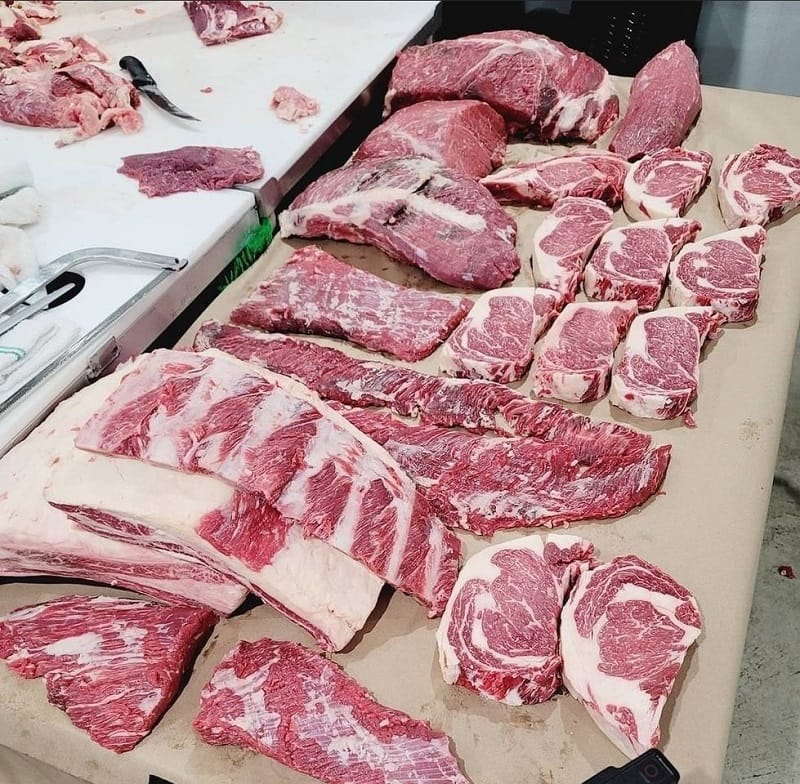
When purchasing a half-cow package, one of the most imortant decisions you’ll need to make is which cuts of meat should be included. After all, the package should offer enough variety to suit your family’s tastes and satisfy your budget. To help you, we’ve compiled a list of the most common cuts that typically come with a half-cow package.
Ribeye
The ribeye is the most popular cut of meat in a half-cow package. This cut of steak is incredibly tender and full of flavor. It is perfect for grilling, pan-frying, and roasting. It also makes an excellent addition to any stew or soup.
Ground beef
Ground beef is another cut of meat that is often included in a half cow package. Ground beef is incredibly versatile and can be used in various dishes such as tacos, burgers, and casseroles. It is an excellent option for those looking for a quick and easy meal.
Flank steak
Flank steak is a tougher cut of meat, but it’s still very flavorful. It’s best cooked quickly over high heat, such as grilling or searing. It’s also great for marinating and slicing into thin strips for stir-fries and fajitas.
Coulotte
Coulotte is a cut of steak that comes from the top sirloin. It’s usually very tender and juicy and best cooked quickly over high heat.
New York strips
The New York strip is another popular steak cut. It’s juicy and full of flavor, and it’s perfect for grilling, pan-frying, or serving with a sauce.
Chuck roasts
Chuck roasts are a great cut of beef for slow-cooking and braising, as the extended cooking time brings out all of the delicious beefy flavors and makes it super tender. Perfect for pot roast or beef stew, chuck roasts are a classic comfort food dish.
Sirloin steaks
Sirloin steaks are fairly lean and flavorful, perfect for grilling or pan-searing. The thick cut of steak also makes them great for marinating or smothering in a rich gravy.
Round roasts
Round roasts are often used to make pot roast, as their leaner cut of beef takes longer to cook and becomes tender. A round roast can be cubed and slow-cooked for a delicious beef stew.
Filet mignon
Filets mignons are incredibly tender and juicy, making them popular for special occasions. Pair a filet mignon with a glass of red wine and some creamy mashed potatoes for a delicious dinner.
Stew meat packs
Stew meat packs are also included in a half-cow package. Stew meat packs are great for making delicious stews and soups, as their smaller size cuts down on cooking time. Stew meat packs are also great for making stir fry or kabobs.
Skirt steak
Skirt steak is a flavorful cut of beef and is often used for fajitas, stir fry, and other dishes. Skirt steak is a thin, boneless cut and is best cooked quickly over high heat to maintain its tenderness.
Flat iron
A flat iron is a boneless cut of beef that has a distinct shape and is usually quite tender. It’s often used in steak sandwiches, stirs fry, and other dishes. It’s best cooked quickly over high heat.
Tri-tip
Tri-tip is a boneless cut of beef that is leaner than other cuts and is often used for roasts, stews, and other dishes. It’s best cooked slowly over low heat to prevent the meat from becoming tough.
Bone-in Short ribs
Bone-in short ribs are a flavorful cut of beef that can be used for braising, slow cooking, and grilling. They’re best cooked slowly over low heat to maintain their tenderness.
Brisket
Brisket is a cut of beef typically used for smoking and barbecuing. It’s best cooked slowly over low heat to ensure the flavors penetrate the meat.
Read more:
- How Much Is A Quarter Cow
- How Many Ribeyes In A Cow
- How Much Is A Whole Cow
- Where Is The Tri Tip On A Cow
- What Part Of The Cow Is Filet Mignon
What Is The Average Weight Of A Half Cow When It’s Sold?
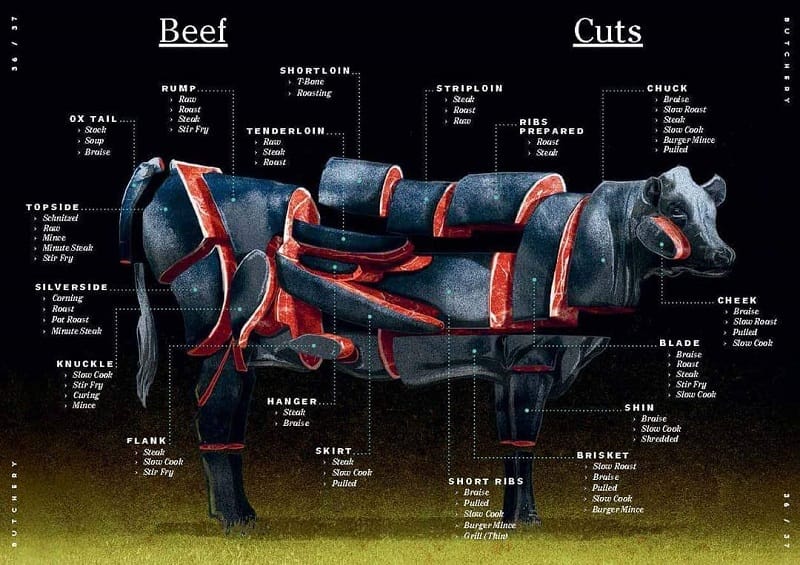
When someone buys a half cow, they might be wondering how much meat they can expect to receive. Based on facts, the average weight of a half cow when it’s sold can vary. On average, half of a beef package typically weighs around 198 pounds. However, the weight can range from 150 pounds to over a few hundred pounds.
It’s important to remember that the weight of the final cuts of meat will depend on the cow’s hanging weight, which is approximately 400 pounds. The cost to have the animal slaughtered is usually around $100, and the hanging weight price is typically around $5.60 per pound. It’s essential to get an estimate from the seller to determine the final price for the finished cuts of beef which should be around $8.01 per pound. Buying a half cow is an excellent way to stock up on high-quality meat for your freezer or share it with family and friends.
Tips For Buying A Half Of A Cow
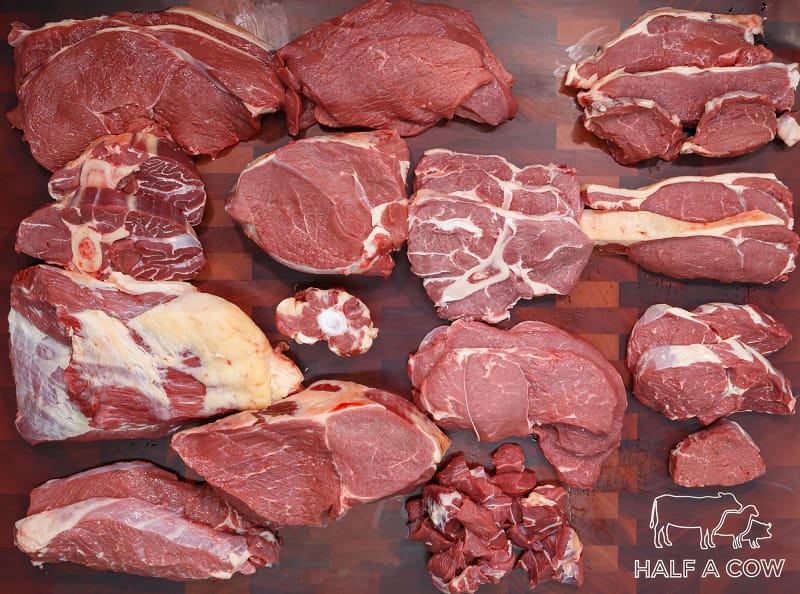
Buying a whole cow can be daunting, and some people prefer to buy half of a cow instead. We’ll provide you with some tips to help you make sure you get the best deal when you buy half of a cow.
- Research the breed: Different breeds of cows have different nutritional needs and can produce different meat quality. Make sure to do your research and understand the breed you’re considering.
- Visit the farm: Visit the farm where the cow will be raised and get to know the farmer. This will help you ensure that the cow is raised humanely and sustainably.
- Ask questions: Don’t be afraid to ask questions! Ask the farmer how the cow is being raised and what type of feed it is given. It would help if you also inquired about the age of the cow and any other details that are important to you.
- Price: Price is always a factor when buying half of a cow. Make sure to shop around and compare prices to get the best deal.
- Personal preferences: Consider your preferences regarding the type of meat you’d like to purchase. Some people prefer grass-fed beef, while others prefer grain-fed.
- Storage: Ensure you have adequate storage for the amount of meat you purchase. You may need a large freezer or a separate storage area for the meat.
Buying half of a cow can be a great way to ensure access to high-quality, nutritious meat. However, it’s important to do your research and ensure you’re getting the best deal.
What Is The Shelf Life Of Cow Meat
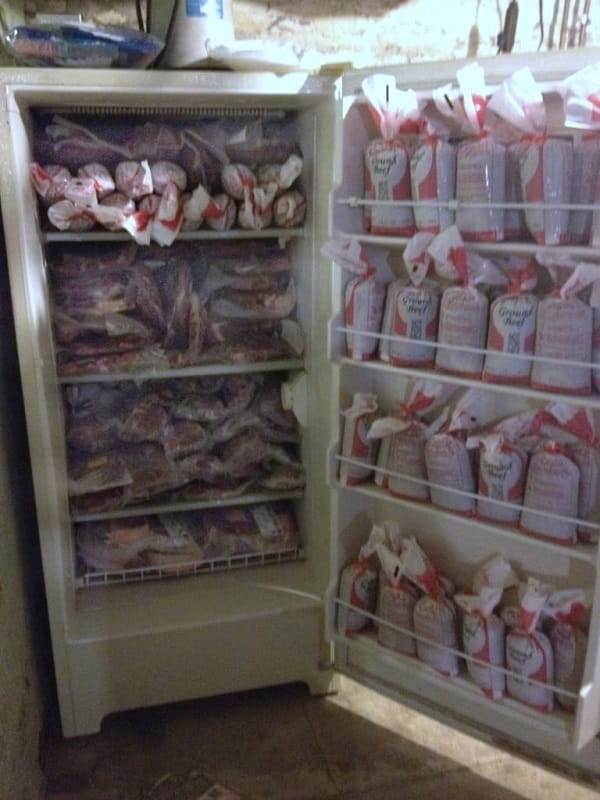
Knowing how long cow meat can last is important to meal planning and food safety. Follow the proper storage guidelines to ensure your cow meat stays safe to eat.
The shelf life of cow meat depends on various factors, including the type of cut, how it is processed, and how it is stored. Generally, cow meat can last up to two weeks in the refrigerator and six to twelve months in the freezer.
Firstly, cow meat should be stored in the refrigerator immediately after purchase. This will ensure that the meat stays fresh and safe to eat. If you plan to store the cow meat in the freezer, it should be frozen as soon as possible and wrapped securely in airtight packaging. Cow meat should not be left at room temperature for over two hours.
Once the cow meat has been cooked, the shelf life of the flesh is greatly reduced. Cow meat cooked should not be left out for more than two hours. Ideally, any cooked cow meat should be consumed immediately after cooking.
If you want to maximize the shelf life of cow meat, you should also consider how it is prepared. For example, salting or marinating cow meat can help to extend its shelf life. However, it is important to note that salting and marinating can also reduce the nutritional value of the meat.
Finally, remember that the shelf life of cow meat also depends on the quality of the meat. For example, frozen cow meat for an extended period may be unsafe to eat, even if it has not expat. Therefore, it is important to scrutinize all cow meat before purchase and consumption.
How Much Freezer Space For Half A Cow?
If someone is considering buying half a cow, they might wonder how much freezer space they need to store all the meat.
It is recommended to have at least eight to 10 cubic feet of freezer space for half a cow. This allows for proper organization and storage of each cut of meat. However, if the person prefers more space or wants to store additional items, a 16 to the 21-cubic-foot freezer is the best size for a whole cow. To put it in perspective, one rule of thumb is to have one cubic foot of freezer space for each 35-40 pounds of cut and wrapped meat, allowing slightly more space when the meat is packaged.
So, if someone orders a half share, they can expect approximately 200 pounds of beef, which will need at least a seven cubic foot freezer. It’s important to consider the amount of freezer space when buying half a cow to ensure proper storage and freshness of the meat.
Shelf-Life Of Frozen Half Of Cow
Frozen half of the cow is popular for many households as it provides convenience and reduces food waste. The shelf-life of the frozen half of a cow varies depending on factors such as storage temperature and packaging.
According to experts, frozen half of the cow can be stored for up to 12 months in a freezer that maintains a temperature of 0°F or lower. It is important to note that the quality of the meat may decline after this time, but it will still be safe to consume. Proper packaging, such as vacuum sealing, can further extend the shelf-life of frozen meat. Labeling the meat with the date of freezing is recommended to ensure it is consumed within a reasonable time frame.
How Long Does Half A Cow Last For A Family Of 4
The answer depends on a variety of factors, including the size of the family, the age of the family members, the family’s dietary preferences, and the frequency of meals eaten at home.
To estimate a rough guide for the amount of food a family of four will get from half a cow, it’s important to understand the different cuts of beef. The most common cuts of beef are the chuck roast, rib roast, sirloin steak, and ground beef. Each cut of beef has different thicknesses and yields different amounts of meat. Generally, around 15 to 20 pounds of beef can be obtained from half a cow.
It’s also important to consider the age of the family members when determining how long half a cow will last. For families with young children, half a cow’s food may last longer, as kids tend to eat smaller portions. On the other hand, families with teenagers may find that the same half a cow doesn’t last as long, as teenagers tend to eat larger portions.
The family’s dietary preferences and the frequency of meals eaten at home will also play a role in determining how long half a cow will last. If the family prefers to eat more plant-based meals, they may find that half a cow will last longer than a family that primarily eats meat. Similarly, if the family eats out more often rather than eating at home, they may find that the same half a cow will last them a shorter amount of time.
How Do You Find A Local Farm?
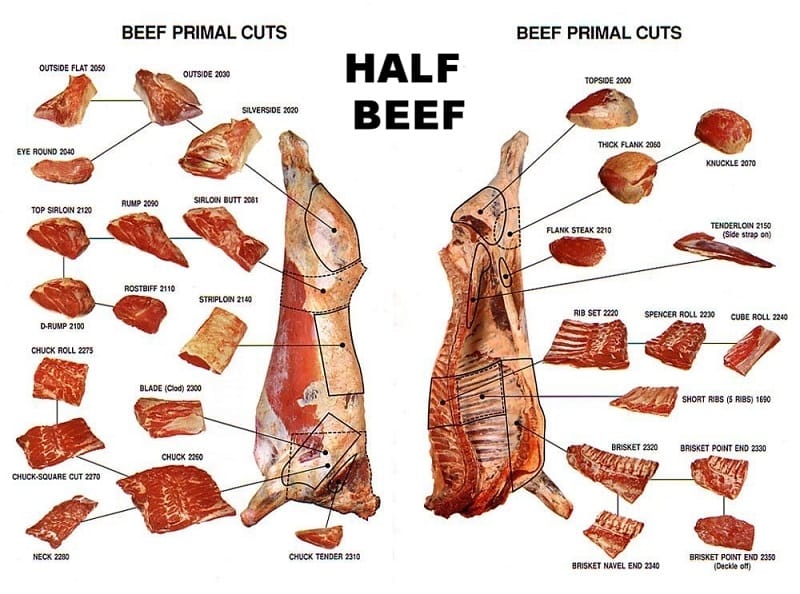
Finding a local farm can be a great way to support the local economy and get fresh, locally-sourced produce. However, finding a local farm can be challenging if you aren’t sure where to start looking. Here are some tips for finding a local farm:
- Ask Around – Talk to friends, family, and neighbors to see if they know of any local farms in your area. They may be able to point you in the right direction or even provide a personal recommendation.
- Check Online – You can use search engines like Google or Bing to type in “farms near me,” You may be surprised at the results. You can also use websites and apps like LocalHarvest.org or EatWellGuide.org to find farms close to you.
- Visit a Farmers Market – Farmer’s markets are great places to find locally-sourced produce, and you may even be able to meet the farmers themselves. Look up farmer’s markets in your area to see when and where they are held.
- Ask at Farms and Farm Stands – If you’re looking for a specific type of produce, call or visit local farms and farm stands to ask what they have available. Many farms have roadside farm stands you can visit to buy their produce.
- Contact Local Agriculture Offices – Local agriculture offices may know of farms in your area or even have a list of local farms you can contact.
Conclusion
In conclusion, the cost of a half cow can vary greatly depending on factors such as the size, quality, and butchering services provided. Generally, a half cow can cost anywhere from $1,500 to $1,800. Other costs are associated with buying a half cow, including a freezer to store the meat, butchering, and processing fees.
Overall, buying a half cow can be a great way to save money and enjoy a variety of cuts of high-quality beef. However, it is crucial to consider the additional costs that come with it and make sure that the cost is within your budget. In the end, the key to answering the question: “How much does a half cow cost?” is to be aware of the different factors that can influence the price.
References:
- https://thekrazycouponlady.com/tips/money/buying-cow-cost-cuts-beef-worth-it
- https://www.gigacalculator.com/articles/how-much-freezer-space-for-half-a-cow/

Hey readers! Chip Holland here, and I’m a Manager of this website. My passion for writing about it only matches my passion for BBQ. Follow my blog for mouth-watering recipes, tips, and tricks for the perfect smoke, grill, and BBQ. I’m sure you won’t be disappointed!
